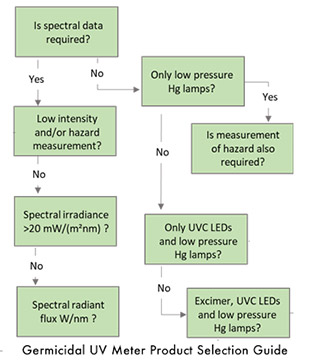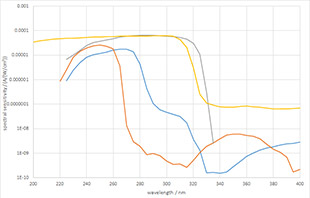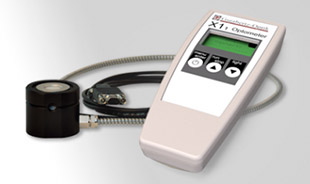The Good News: Using Ultraviolet Optical Radiation Works
Applying ultraviolet optical radiation is a known mitigation method for air, water and surface germicidal / bactericidal disinfection. Available today, you can find a myriad of UV germicidal irradiance devices utilizing the power of UV-C to neutralize viruses and bacteria in air, water and surfaces. They come in a variety of formats: hand-held wands, robots, regular lamp assemblies - and in big blue UV-C lamp fixtures in grocery stores in Hamburg, Germany.
The Bad News: Not All UV Disinfecting Devices Are Effective
The COVID-19 pandemic has sparked a marked increase in demand for germicidal UV products and for UV-C units in particular as UV-C has proven most effective. The problem, of course, is that these UV & UV-C sanitizing products range widely in quality and effectiveness. Unfortunately, some devices emit no UV at all.
Finding Germicidal Devices That Actually Sanitize
So, how do you ensure UVC emjiters provide effective and safe disinfection against the corona virus? That's the job of UV & UV-C Radiometers. Radiometers first measure the units to ensure that enough of the right wavelengths of UV are actually being emitted to verifiably kill the germs. These UV light meters then measure the units to ensure that the personnel occupying the area are not at risk for UV hazard. However, there's a Catch-22: UV & UV-C meters are subject to accuracy concerns based on the quality of components, calibration method and the manufacturer’s experience in UV measurement. This wide range in radiometer qualifications from different manufacturers can result in differences in UV measurements of up to 100% in some cases.
UV Radiometer Quality Standards
In March 1998 the EU Thematic UV Network for Ultraviolet Measurements formed Working Group 1 tasked with generating a means of qualifying UV radiometers. The result was the TUVN report: Working Group (2000). Working Group 1: Guidance for UV power meter classification for particular applications, “Characterizing the Performance of Integral Measuring UV-Meters,” UV News, Part A: Final report of WG1, 26 pp. (Reprinted from UV News Issue 12 / March 2017 p.36 ff with permission of Aalto University)
This work became the forerunner to technical document CIE 220:2016 - Characterization and Calibration Method of UV Radiometers. CIE 220, prepared by CIE Technical Committee TC2-47, describes quality indices for UV radiometers, which enable manufacturers and users to characterize instruments on a common basis. To harmonize CIE documents, the quality indices described in this document relate to the quality indices described in Joint ISO/CIE International Standard ISO/CIE 19476:2014(E) (formerly CIE S 023/E:2013).
What Makes A Quality UV Radiometer? Look for This Data
Many factors are in play for UV radiometer qualification. For reference instruments (highest quality instruments) the manufacturer should ideally provide the following data for each individually measured and characterized instrument:
- target action spectrum
- reference-spectrum sources used for calculations of effective responsivities
- type of calibration source used to calibrate the effective responsivity under specific conditions
- spectral response
- wavelength corresponding to peak spectral responsivity
- usable dose or irradiance range, as appropriate
- target angular response (cosine, 2π etc.)
- allowed operating temperature interval and associated temperature coefficient
- calibration temperature during calibration of the reference instrument
- allowed humidity during operation
- tabulated values of the spectral responsivity including assigned uncertainties
- tabulated values of angular response
- quality indices including estimated uncertainties
- reference plane of calibration
Who Should Read The TUVN Measuring UV-Meters Report?
Everyone who is interested in buying a UV-C meter should read it. Why? The TUVN report gives you the qualification criteria you need for making an informed purchase decision. In addition, you’ll learn how to perform reliable measurements and how to calculate measurement uncertainty budgets. Simply put: the more you know, the more accurate the radiometry you’ll provide in the fight against the Corona virus.
References:
CIE (2016). CIE 220:2016, Characterization and Calibration Method of UV Radiometers, CIE, Vienna, Austria, 2016, 52 pp.
Working Group (2000). Working Group 1: Guidance for UV power meter classification for particular applications, “Characterizing the Performance of Integral Measuring UV-Meters,” UV News, Part A: Final report of WG1, 26 pp.





